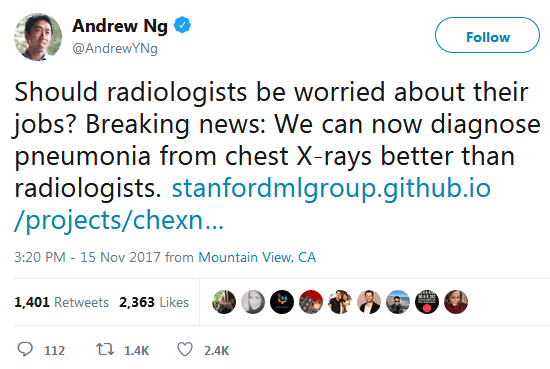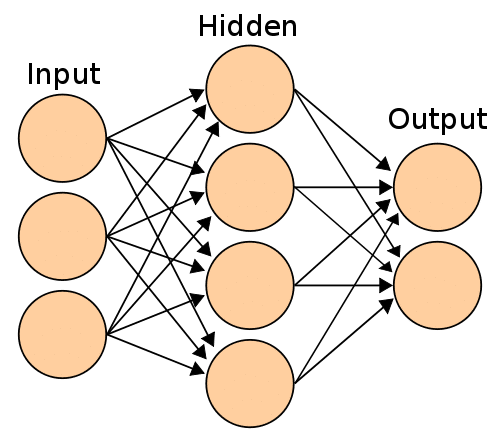Introduction
Artificial intelligence, machine learning and neural networks are continuously in the news. Beyond self-driving cars and movie recommendations, AI is used in an increasingly broad set of applications. For example:
- Fraud litigation prediction 1
- Predicting whether construction projects will go wrong 2
- Cyber-forensics 3
- Radiology research 4 using image networks designed to learn by an adversarial process.
One controversial aspect of the AI explosion is its effect on medical imaging. Many articles proclaim that AI can detect pathology in diagnostic images better than humans. Turing Prize winner Geoffrey Hinton, a professor the University of Toronto who continues to make fundamental contributions to the field, stated in 2017 that:
They should stop training radiologists now. It’s just completely obvious within five years that deep learning is going to do better than radiologists. It might take ten years, but we’ve got plenty of radiologists already. I said this at a hospital, and it didn’t go down too well.
Andrew Ng, Baidu’s chief scientist and a prominent computer science researcher, tweeted:

AI, machine learning and deep learning defined
Artificial Intelligence (AI), Neural Networks and Deep Learning each mean different things. Broadly, these terms are used to describe non-programmed computer systems. Instead of relying on humans to specify desired behavior in a computer language, these systems look for patterns in data.
One definition of artificial intelligence is “an area of computer science that emphasizes the creation of intelligent machines that work and react like humans.”
“Intelligent machines” do not have an IQ. Rather, they respond to the information they are given like a person might. When Facebook asks you whether a post is an advertisement, its AI has noted that the post’s word sequence resembles those it has seen in advertisements. It does not detect commercial intent by understanding the text.
Machine learning is the method the computer system uses to gain intelligent behavior. Over the past 50 years, numerous ways to do this have been invented. The most popular approach today, neural networks, are a sub-category of machine learning. These are called “neural” since they are designed to function analogously to nerve cells.

Figure 1: A neural network comprises an input layer, one or more hidden layers, and an output layer. The network is usually implemented in software. Data is fed to the input layer, the hidden layer does some processing, and the output layer communicates the result to the outside world. Each circle represents an “artificial neuron” which roughly acts like a nerve cell.
Deep learning is a type of neural network which includes many hidden layers. Figure 1 shows only one, so is not a deep neural network. One of the reasons neural networks have become much more powerful in the last decade is that methods were discovered to train deep networks.
Medical imaging and AI
The clinical practice of radiology faces many conflicts, three of which were summarized in a recent paper in the Journal of the American College of Radiology 5:
- Medical care is moving out of the hospital, leading to a decrease in demand for imaging
- Bundled payments and capitation mean that imaging becomes a cost rather than a profit center
- The effect of machine learning has yet to be felt but may, in time, end the specialty.
Focusing on the authors’ third point, some analysis will show that the truth about AI and radiology is less black and white than breathless news articles imply.
First, a problem with image-processing neural networks, deep or otherwise, is that they cannot yet explain how they reach their diagnostic conclusions. Their conclusory outputs are like looking at the answer section in the back of a textbook without understanding the route to the answer. In medicine, where the art is often to decide on treatment based on conflicting data, this is much less helpful than a system capable of explaining its reasoning.
Another issue is that the rush to publish in a red-hot field has often led to problems with the design of studies. Particularly, validation using image data generated at clinical sites other than the one authoring the study has been lacking. A recent review 6 states that only 6% of 516 published studies performed this external validation.
Next, it is unclear how AI will fit into the reimbursement climate. How will the stakeholders in medicine and reimbursement react to this technology? In the short term it allows radiologists to read examinations faster, while other advances in medical imaging technology increase the number of images which must be interpreted for each patient.
Finally, there are challenges in deploying AI into a hospital’s infrastructure. Hospital software is highly and under fire from malicious actors. For example, the Department of Homeland Security’s list of WannaCry malware targets includes numerous medical devices. System administrators must avoid compromising the security of their IT system, which creates resistance to change.
Radiology Artificial Intelligence Expert Witness – Potential Cases
Artificial intelligence will have a profound effect on the practice of medicine, and radiology is set to be the first area affected. It takes little foresight to imagine the litigation effects of black-box systems rendering medical decisions.
A medical artificial intelligence expert witness can assist retaining counsel in navigating cases involving AI in medicine. Broad and deep knowledge of the underlying science and technology can simplify what is at issue for both retaining counsel and the finder of fact. An expert with good communication capabilities will cut through jargon and complexity to teach the essentials of the technical components of the case. The cases calling for a Medical artificial intelligence AI expert witness will presumably involve patent disputes, trade secrets, product liability and medical negligence actions.
References
- Hsueh-Ju Chen, Shaio-Yan Huang, Chung-Long Kuo, Using the artificial neural network to predict fraud litigation: Some empirical evidence from emerging markets, Expert Systems with Applications, Volume 36, Issue 2, Part 1, 2009, 1478-1484, ISSN 0957-4174, https://doi.org/10.1016/j.eswa.2007.11.030
- Yitmen and E. Soujeri, An artificial neural network model for estimating the influence of change orders on project performance and dispute resolution. In Computing in Civil and Building Engineering, Proceedings of the International Conference, W. Tizani (Editor), 30 June-2 July 2010, Nottingham, UK, Nottingham University Press, Paper 147, 293, ISBN 978-1-907284-60-1, http://www.engineering.nottingham.ac.uk/icccbe/proceedings/pdf/pf147.pdf
- Nickson M. Karie, Victor R. Kebande, H.S. Venter, Diverging deep learning cognitive computing techniques into cyber forensics, Forensic Science International: Synergy, Volume 1, 2019, 61-67, ISSN 2589-871X, https://doi.org/10.1016/j.fsisyn.2019.03.006
- F. Galbusera, et al, Exploring the Potential of Generative Adversarial Networks for Synthesizing Radiological Images of the Spine to be Used in In Silico Trials, Frontiers in Bioengineering and Biotechnology 6, 53 (2018) https://doi.org/10.3389/fbioe.2018.00053
- Chockley and E. Emanuel, The End of Radiology? Three threats to the future practice of radiology, J. Am. Coll. Radiol. 13, 1415-1450 (2016), https://doi.org/10.1016/j.jacr.2016.07.010
- DW Kim, HY Jang, KW Kim, Y Shin, SH Park, Design Characteristics of Studies Reporting the Performance of Artificial Intelligence Algorithms for Diagnostic Analysis of Medical Images: Results from Recently Published Papers, Korean J Radiol. 20(3), 405-410 (2019) https://doi.org/10.3348/kjr.2019.0025
Leave a Reply